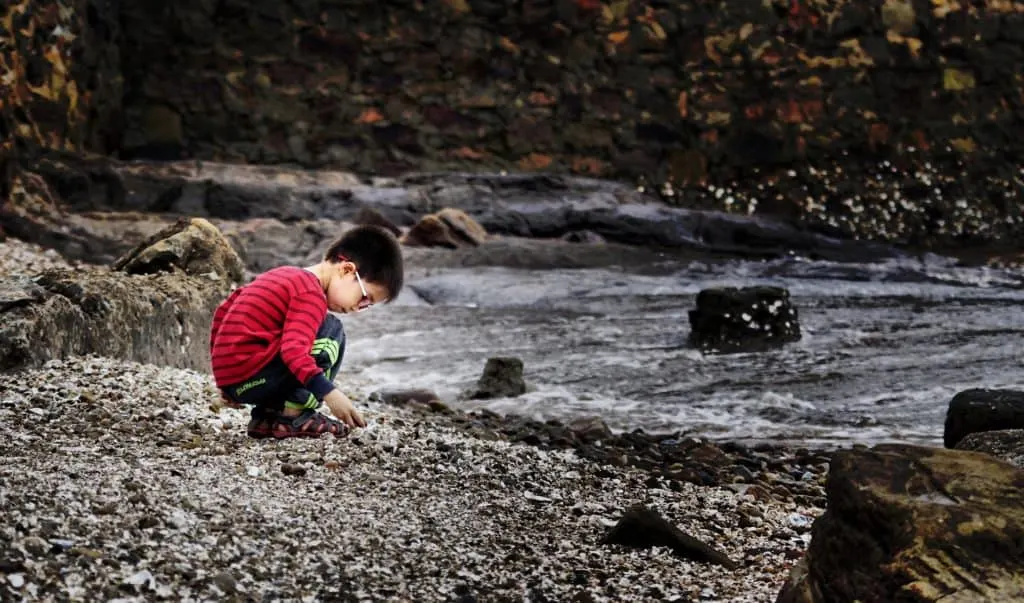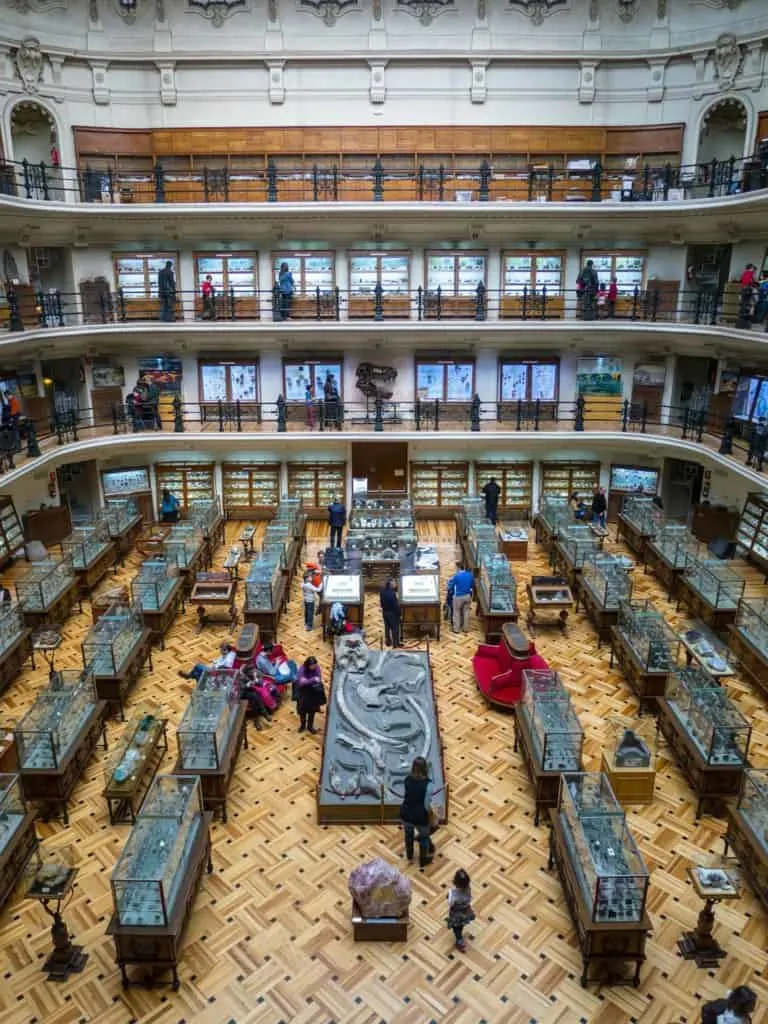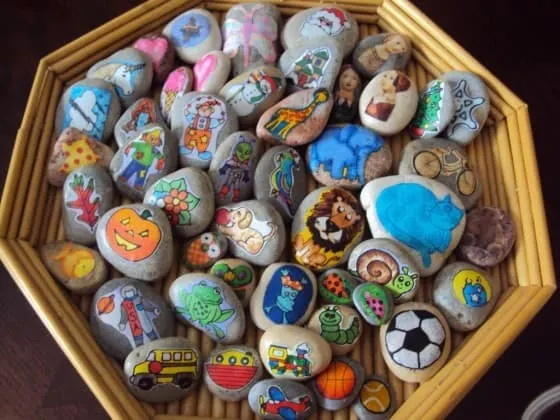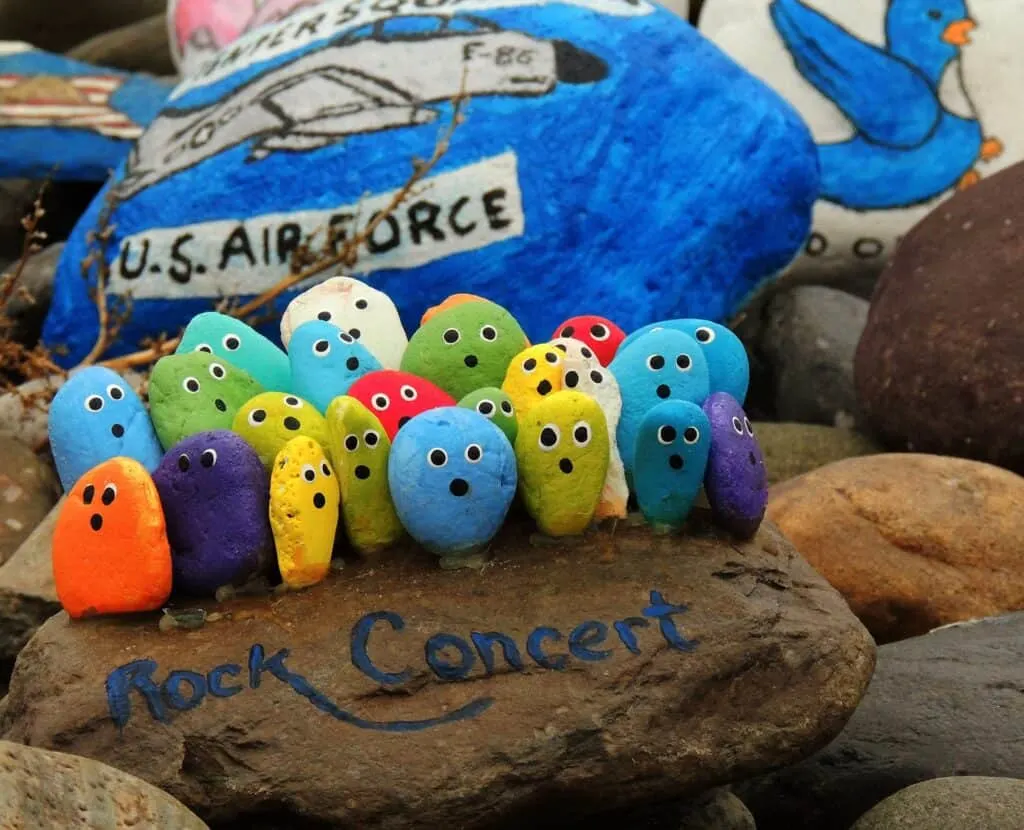As an Amazon Associate, I earn from qualifying purchases with no additional costs for you.
Getting your kids into rock collecting is not just fun but educational. Kids love rocks. Since they are toddlers, they always seem attracted to rocks of all kinds. Of course, when they were that young, they may have been putting them in their mouth, which is not a good idea. But getting your child interested in collecting rocks can be easy if you look at it from their point of view. So, how to get them started?
Take your kids to the beach, river, or somewhere else where there are a lot of rocks. If you start them early, you should not have trouble getting them interested because rocks are fascinating with their unique colors and shapes. With older kids, you may have to be more creative.
I have prepared eleven ways to get your children into rock collecting in this article. So sit back and find out what they are.

If you want to check out the best books about rockhounding for kids, you can find them by clicking here (Amazon link).
Get Educated on the Geology in Your Area
Find out what rocks and minerals are common to your area. You can look it up online or visit your local library. You can discover a lot by Googling rocks and minerals in your area.
Rocks come in three different types depending on how they were formed:
- Igneous rocks include basalt, granite, pumice, and obsidian
- Metamorphic rocks are phyllite, soapstone, schist, marble, quartzite, and gneiss
- Sedimentary rocks are sandstone, Castile, shale, and limestone.
Minerals have to have five basic things, which include:
- A definite chemical compound that is the same wherever it occurs
- An ordered internal structure that typically forms crystals
- Must be in solid form at room temperature (except for mercury)
- Has to be inorganic (not alive)
- Must be naturally occurring (not made by man)
Learning about the rocks and minerals in your area before introducing rock collecting to your kids is best. That way, you know what you are talking about. You do not have to be an expert. Just get some knowledge first. This also helps you learn how and where to find rocks and minerals near you.
Collect Some Cool Rocks of Your Own
The best way to entice your kids into rock collecting is to show them your own collection. Make sure it is colorful and interesting, not just a box of boring stones you grabbed from the driveway. If you want them to be interested, show them how cool your collection is.
Every collection should be sorted and labeled. You can get a rock-collecting kit online or make your own from something you have at home.
Really, you can use just about anything with compartments to separate the rocks from each other.
Here are some containers you can use for a rock collection:
- Egg carton
- Tacklebox
- Trinket box
- An old jewelry box
- Jars
- Toolbox
- Shadowbox
- Shoebox
TIP: Starting a rock collection can be fun for kids and you, too. Check out useful tips on how to start a rock collection in the article below:
How to Start Rock Collecting? Complete Guide for Beginners
Start Out Simple
If your kids are young, do not try to give them too much information. Make it fun. Tell them you are going exploring for gemstones or dinosaur bones. Anything to get them interested in searching for rocks. And it is true; you can find gems and fossils everywhere.
Depending on your child’s age, getting them into rock collecting can be as easy as hiking at your local park or walking around your neighborhood. If you look around your yard, you can probably find a great collection of rocks.
But if you want to collect a more varied group of rocks, some of the best places to look are near water sources like:
- Lakes
- Rivers
- Oceans
- Creeks
- Ponds
- Streams
Make sure that it is not illegal to take rocks wherever you are collecting rocks. In many state and national parks, taking rocks or any other items you find is illegal.
Check with a park ranger or other official where you are hunting for rocks. And do not go on private property. Teach your kids to respect other people’s property while rock hunting.
Give each of your children a bucket or bag to put rocks in, and let them start searching. Carry a backpack with small shovels (trowels) and maybe even a small chisel to remove really cool rocks from large boulders.
You may be surprised at how easily they catch onto this new adventure. It is like a treasure hunt, and kids love treasure hunting. Actually, most adults do, too.
TIP: Rockhounding is a great outdoor activity that almost all kids will love. Even if you are a beginner, you can easily find cool rocks. To know more about rockhounding, read this ultimate guide:
How to Start Rockhounding: The Ultimate Beginner’s Guide
Get Them Some Rock Books
Depending on your children’s ages, books with pictures of rocks and minerals are great teaching tools. Not only can they see some really pretty rocks and minerals, but they can also learn how to identify the rocks they find.
You can go to the library for books if you want to. However, it is better to get your kids their own books they can keep and take with them rock hunting. They may even want to write in it. You cannot do that with library books!
Make sure you get a book that has good photos of real rocks and minerals with the names to help you all figure out what they are. Most adults need help identifying many of the rocks and minerals they find.
If you decide to buy a rockhounding book for kids, I personally recommend buying this amazing book for kids (Amazon link).
Teach the kids the names of each rock and mineral that they have. If they are too young to read and write, help them make labels for their collection boxes or jars. That way, they will always know what they have, and they can show their rock collection to others.
Encourage your kids to keep their collection and add rocks to it whenever they see one they like. They may be camping or fishing and see a rock that catches their eye.
They can take it home and add it to their collection. By age, they could have a huge collection they can share with their kids.
TIP: The best way to identify the mineral is to consult with a specialist or with a rocks and minerals book. Find out the best books about rocks and minerals in the article below:
5 Best Books for Identifying Rocks & Minerals You Must Read
Take Them to a Museum or Geological Center

If your kids are under five, the best kind of museum to take them to is a children’s museum with interactive exhibits. Because many preschoolers get bored quickly just looking at things in glass cases, they need hands-on activities to keep their interest.
Many geological centers and museums have rock piles your kids can dig through. Some have archaeological sites where they can learn how to gently uncover fossils and other cool items buried in the dirt. What kid doesn’t love digging in the dirt?
Depending on where you live, you may be able to find a gemstone farm or diamond farm where you and the kids can search for real diamonds and other gemstones.
In Arkansas, the Crater of Diamonds State Park has a 37.5-acre field you can dig through, and you get to keep whatever you find. It is one of the biggest diamond craters in the world.
Visit a Rock Quarry
If you can find a rock quarry near you, that is great because quarries are like a giant rock collection to explore and enjoy.
A quarry is a pit or hole in the ground where workers remove the stone. In fact, even if you have to drive an hour or more, it is still worth it. But first, ensure they allow visits and see if they give tours.
On a tour of the rock quarry, you and the kids can learn about the following:
- How they blow up giant boulders and rock walls
- Drilling the quarry holes
- Crushing the pieces to make them smaller
- Sorting them to find any minerals and fossils hidden inside
You may even get to dig through one of the rock pits. See if you can come at a time when they are going to do some blasting. The kids will love that! You should also ask if you and the kids can watch them do some drilling. You may get lucky and find a quarry with special tours for kids to enjoy.
TIP: It is important to know what to do when doing rockhounding. Safety is always the most important. Read these tips for your safety while rockhounding + tips not only for beginners:
PRO Tips for Beginner & Experienced Rockhounds + Safety Tips
Show Them How Ordinary Stones Can Turn into Beautiful Gems
Rock tumblers are simple machines that spin your rocks around with water, grit, or sand for days or weeks to make them into polished stones. Even a plain old boring rock can look pretty after a few weeks in the tumbler.
When you first start tumbling your rocks, you will use a real course grit to soften the edges of the rocks. Then, you will change the grit every two weeks to finer and finer sand to make your rocks smooth and shiny.
You may put in a bunch of dull, gray rocks one day and have beautiful, vibrantly colored gems a month or two later. One of the best rocks for tumbling is agate since it has pretty patterns and is translucent because it is quartz.
The rocks you do not want to use are those that are crumbly and soft, such as:
- Talc
- Soapstone
- Gypsum
- Calcite
- Fluorite
The extra-hard ones like diamonds and corundum are not great choices either. Younger kids will get bored waiting several weeks or months to see how they change, so make sure you let them take a look once a week or so. That way, they can see how the process is working to make their rocks smooth and shiny.
Introduce Them to Rock Painting

Sometimes, a rock is just a rock like a typical garden variety stone that people usually use in gravel driveways or roads. These types of rocks are great for rock painting.
Kids love to paint, and they love rocks, so it just stands to reason that rock painting will be something they will enjoy. Many adults have gotten into rock painting fun, too. This activity with rock painting groups has become very popular on Facebook.
Some of the ideas for rock painting include:
- Painting them solid colors
- Splash or splatter painting (splash or splatter paint onto them)
- Shake painting (put them in a can with paint and shake)
- Use paint markers to make faces
- Paint them as animals or flowers
- Paint them as you see them (if it looks like a globe, paint the earth if it looks like a bird, paint it as a bird)
TIP: Did you know food colors are great for painting rocks? Yes, they are safe and suitable for rocks. Check out these 5 simple steps on how to dye rocks with food coloring in the article below:
How to Dye Rocks with Food Coloring? Follow These 5 Steps
Join a Rock Painting Group
Why not join a rock painting group in an area near you? The rock painting groups on Facebook are fun ways to get your kids involved in more things to do with rocks. You just paint your rocks and put the name of the Facebook group on the back.
Hide your painted rocks in parks, shopping centers, beaches, or anywhere you can think of. When it is found, the finder will take a picture and post it to your group so you can see who found it. Then they hide it again for others to find.
It is actually pretty exciting to see how many people find your rocks and where people re-hide them. You can even go look for rocks that other people painted and hid. Many people will post pictures of their rocks and give you a hint on where to find them before they hide them.
Make a Rock Garden

If you have a garden, flower bed, or just a nice space in the yard you can decorate it with rocks and help the kids make a rock garden with the rocks they find. You can use:
- Painted rocks
- Tumbled rocks
- Rocks as they are found
Another cute idea is to paint the rocks to look like flowers and make a flower-rock garden. Or how about painting the rocks to look like vegetables or fruits? You can even have the kids paint them to look like ladybugs or another type of critter.
No matter what your kids want to do with the rocks, make sure you are using non-toxic paint or paint pens that will not leach into the dirt. Washable markers are good, but they won’t last very long if it rains a lot in your area. It is best to use colored Sharpies or other paint pens.
BTW: Do you want to know more about rock and mineral identification? The books listed below are the best ones you can find on the internet (Amazon links):
- Smithsonian Handbooks: Rocks & Minerals
- Gemstone & Crystal Properties (Quick Study Home)
- Ultimate Explorer Field Guide: Rocks and Minerals (National Geographic Kids)
TIP: Do your kids lick the rocks? Even professional geologists do that!🙂 Find out why they lick rocks and how to do it properly in the article below:
Licking Rocks in Geology: Why & How (Answered by Geologist)
Buy or Create Some Pet Rocks
Pet rocks are adorable for young kids and can even be fun for older ones. Who doesn’t like to stick googly eyes and a face on a rock? Even most adults can get in on that fun.
Fun Fact: The original Pet Rock was made by Gary Ross Dahl in 1975. He was thinking up new ways to make money and jokingly told his friends he could sell pet rocks. And he sure did! He made millions! Each rock was just a smooth river rock, but it came in its own box (like a hamster box) with a book about caring for your “pet” rock.
You do not have to buy your kids a pet rock, though. They can make their own pretty easily. You don’t even have to be very crafty. Just give the kids each some self-sticking googly eyes and let them stick them on whatever rock they want.
They can even give their pet rock a name and make furniture and a house for it. Just use a shoebox or another cardboard box. If they want to draw or paint their own faces on them, that is good too.
Their pet rock does not have to be a “human,” either. They can make their pet rock into anything, such as:
- Animals
- Insects
- Fish
- Birds
- Aliens
- Monsters
TIP: Another way to increase children’s interest in rocks is to tell them interesting facts about different rocks. Check out the cool facts about igneous rocks in the article below:
11 Cool & Interesting Facts About Igneous Rocks (Must Read)
Try Using Technology to Entice the Older Kids
It can be difficult to get your pre-teens or teenage kids interested in anything that does not have to do with their cell phones or tablets. Luckily, some technical ways exist to get them in the rock-collecting mood.
First, show them some awesome gemstones online and other geological items that may interest them. Some ideas that may work include:
| Popular Rocks & Minerals | Common Locations |
|---|---|
| Quartz | Common everywhere |
| Tourmaline | Mostly found in California and Maine |
| Opal | Often found in California, Oregon, Idaho, and Nevada |
| Garnet | It can be found anywhere in the southwestern United States |
| Jade | Common in Washington, Wyoming, and California |
| Turquoise | Can be found anywhere in the southwestern United States |
| Petrified wood | Found everywhere |
| Fossils | Found near water sources or quarries |
| Arrowheads | Often found by water or in open fields |
If these beauties do not get your kid in the mood to hunt for rocks, try rock painting and finding groups on Facebook. These are interesting to everyone, and since adolescents are always on Facebook, that is a fun way to entice them to join in.
TIP: Did you know you can find a lot of gemstones in your backyard? It is the best way to start rock collecting for your kids. So feel free to find out what gemstones you can find in your backyard in this article:
12 Gemstones You Can Find in Your Backyard Right Now
Making Some Money
How about telling your kids that they can make money finding gemstones? Sure, it may be rare, but it happens. And if that is what it takes to get your kids off the phone and out the door, why not try it?
What about making jewelry with the rock tumbler? Make some pretty gemstones yourself before trying to get them interested. Show them what they can do with the rocks they collect.
Your daughter may enjoy making herself and her friends a pretty necklace or earrings. And your son may want to make his girlfriend something pretty to wear.
No matter how you get your kids interested in rock collecting, encourage them to get others into it, too. Maybe they can make a rock-collecting group.
They could even start a business making pet rocks or rock jewelry. You never know. Your kids may be the next millionaires with their rock-collecting business!
TIP: Do you know how to recognize valuable rocks and minerals? Do you know why some gemstones are so cheap? Learn more before you start selling your rocks and minerals from these articles:
6 Signs That a Rock Is Valuable + Examples & Location Tips
Why Are Some Gemstones So Cheap? You Should Know This
